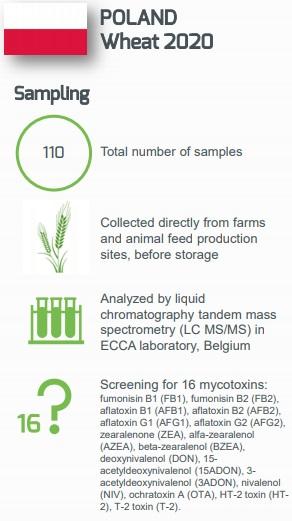Mycotoxin Contamination in Wheat from Poland harvested in 2020
Published: December 18, 2020
By: Margaux Lecolinet, Global Marketing Manager Mycotoxins Management. Julia Dvorska, Global Scientific & Technical Manager Mycotoxin Management
Based on the results of this survey, the 2020 wheat crop in Poland should not automatically be considered safe for inclusion in finished feed rations for all animal species.
Special attention should be paid to the medium-high average concentration of DON (1102 μg/kg), which was found in 71% of the samples with maximum concentration 9800 μg/kg. Average HT-2 and T-2 toxins level according to our risk assessment table present low-medium risk to sensitive animals as poultry, piglets, sows and boars. Levels of ZEA and OTA are low and present low risk for the animal health and performance.
Taking into account present mycotoxins and their levels, wheat should be used in levels not higher than 50% to the ration to avoid negative effect in animals and not to exceed the recommendation level for DON in EU for sensitive animals like pigs, calves etc.
The results of new harvested wheat analysis conducted in 2020 by Adisseo in Poland concludes that this year’s harvest is of concerning quality in terms of mycotoxin contamination. Also, Mycotoxin Management product supplementation to animal feeds is an effective strategy to prevent negative effect of mycotoxins on animal health and performance.

Mycotoxin contamination in newly harvested grain is a very important parameter to consider. That grain is used to feed the animals for the whole year, until the next harvest. As the saying goes, “knowing the enemy is half the battle won.” In turn, if we know the level of contamination, we can think about the best use of the wheat: to which animal species it can be fed (avoiding the more sensitive species in cases of high contamination or decreasing the level of wheat in their diet) and which MycoMan Program product should be used to decrease possible negative effects of contamination on animal performance and health. Read the complete harvest bulletin here
Related topics
Authors:
Join to be able to comment.
Once you join Engormix, you will be able to participate in all content and forums.
* Required information
Would you like to discuss another topic? Create a new post to engage with experts in the community.
Create a post






